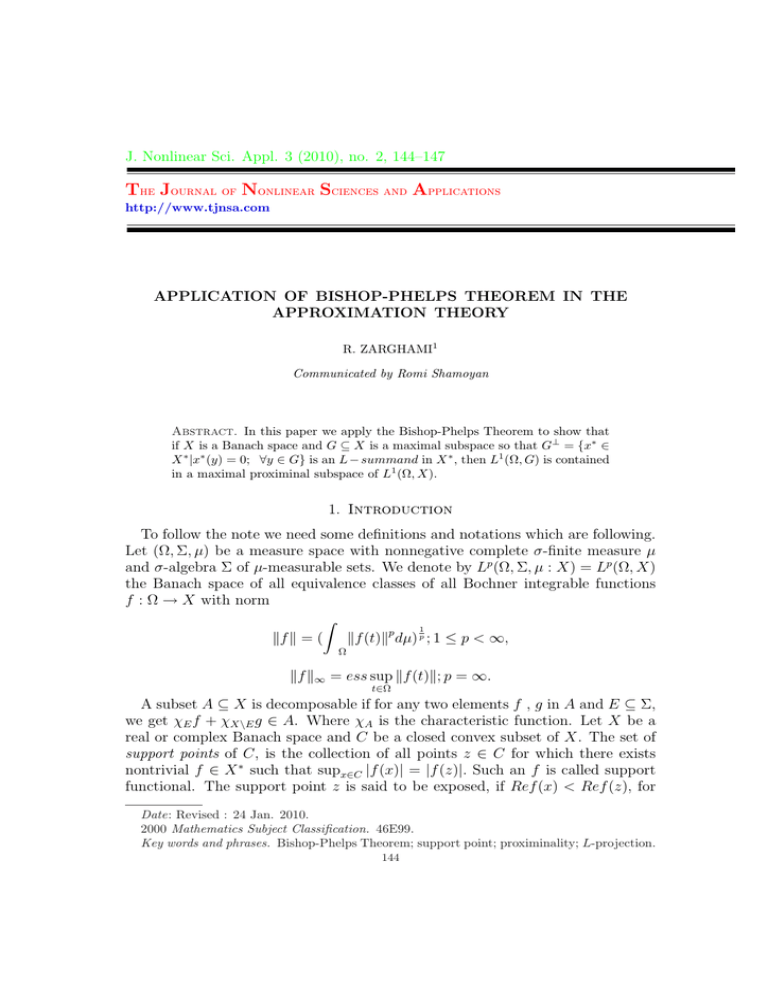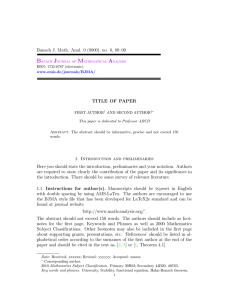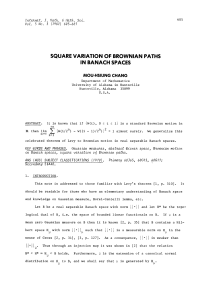T J N S
advertisement

J. Nonlinear Sci. Appl. 3 (2010), no. 2, 144–147
The Journal of Nonlinear Sciences and Applications
http://www.tjnsa.com
APPLICATION OF BISHOP-PHELPS THEOREM IN THE
APPROXIMATION THEORY
R. ZARGHAMI1
Communicated by Romi Shamoyan
Abstract. In this paper we apply the Bishop-Phelps Theorem to show that
if X is a Banach space and G ⊆ X is a maximal subspace so that G⊥ = {x∗ ∈
X ∗ |x∗ (y) = 0; ∀y ∈ G} is an L − summand in X ∗ , then L1 (Ω, G) is contained
in a maximal proximinal subspace of L1 (Ω, X).
1. Introduction
To follow the note we need some definitions and notations which are following.
Let (Ω, Σ, µ) be a measure space with nonnegative complete σ-finite measure µ
and σ-algebra Σ of µ-measurable sets. We denote by Lp (Ω, Σ, µ : X) = Lp (Ω, X)
the Banach space of all equivalence classes of all Bochner integrable functions
f : Ω → X with norm
Z
1
kf k = (
kf (t)kp dµ) p ; 1 ≤ p < ∞,
Ω
kf k∞ = ess sup kf (t)k; p = ∞.
t∈Ω
A subset A ⊆ X is decomposable if for any two elements f , g in A and E ⊆ Σ,
we get χE f + χX\E g ∈ A. Where χA is the characteristic function. Let X be a
real or complex Banach space and C be a closed convex subset of X. The set of
support points of C, is the collection of all points z ∈ C for which there exists
nontrivial f ∈ X ∗ such that supx∈C |f (x)| = |f (z)|. Such an f is called support
functional. The support point z is said to be exposed, if Ref (x) < Ref (z), for
Date: Revised : 24 Jan. 2010.
2000 Mathematics Subject Classification. 46E99.
Key words and phrases. Bishop-Phelps Theorem; support point; proximinality; L-projection.
144
APPLICATION OF BISHOP-PHELPS THEOREM
145
x(6= z) ∈ C. We denote by SuppC and ΣC the set of support points and support
functionals, respectively. Bishop and Phelps [1, 7] have shown that if C is a
closed convex and bounded subset of X then SuppC is dense in the boundary of
C and ΣC is dense in X ∗ . The complex case of the Bishop-Phelps Theorem is
also studied in [6, 8] and some results are given.
Let X be a Banach space and G a closed subspace of X. The subspace G is
called proximinal in X if for every x ∈ X there exists at least one y ∈ G such
that
kx − yk = inf {kx − zk : z ∈ G}.
A linear projecton P : X −→ Y is called an L − projecton if
kxk = kP xk + kx − P xk; ∀x ∈ X.
A closed subspace Y ⊂ X is called an L − summand if it is the range of
an L − projection. The natural question is that, whether or not L1 (Ω, G) is
proximinal in L1 (Ω, X) if G is proximinal in X [4]. We will show that if G⊥ is
an L − summand then L1 (Ω, G) is contained in a maximal proximinal subspace
of L1 (Ω, X).
2. The main results
Theorem 2.1. [5] If X is a Banach space and T ∈ X ∗ , then kerT is a proximinal
set in X if and only if T supports some points of the closed unit ball of X.
Lemma 2.2. Let X be a Banach space and G a support set in X. Suppose
L1 (Ω, G) is a decomposable set. Then each constant function of L1 (Ω, G) is a
support point for L1 (Ω, G).
Proof. Let g0 ∈ L1 (Ω, G) be a constant function, then there exists a point x0 ∈ G
such that g0 (t) = x0 . Since G is a support set, we have
∃T0 ∈ X ∗ s.t. infG T0 = T0 (x0 ).
We define F0 : L1 (Ω, X) → R as follows:
Z
F0 (g) =
T0 (g(t))dµ.
Ω
1
∗
It is obvious that F0 ∈ L (Ω, X) , because if
gn → g
then
(kgn − gk → 0),
Z
|F0 (gn ) − F0 (g)| = |
T0 (gn (t) − g(t))dµ|
Ω
Z
≤
|T0 (gn (t) − g(t))|dµ
Ω
Z
≤
kT0 kkgn (t) − g(t)kdµ
Ω
= kT0 kkgn − gk → 0.
(2.1)
146
ZARGHAMI
hence F0 (gn ) → F0 (g) therefore F0 ∈ L1 (Ω, X)∗ .
Now by Theorem 2.2 [3], we have
Z
infL1 (Ω,G) F0 = infL1 (Ω,G)
T0 (g(t))dµ
Ω
Z
=
T0 (x0 )dµ = T0 (x0 ).
Ω
(2.2)
Note that the middle equality is true, because L1 (Ω, G) is a decomposable set.
By letting g0 (t) = x0 we get that g0 ∈ L1 (Ω, G), and the required result follows:
infL1 (Ω,G) F0 = F0 (g0 ) = T0 (x0 ) = infG T0 .
Therefore, g0 ∈ L1 (Ω, G) is a support point for L1 (Ω, G).
¤
Theorem 2.3. (See Proposition 1.1 of [2]). Let G be a subspace of a Banach
space X such that G⊥ = {x∗ ∈ X ∗ |x∗ (y) = 0; ∀y ∈ G} be an L − summand in
X ∗ , then G is proximinal in X.
By applying the above results we will have the following theorem.
Theorem 2.4. Let X be a Banach space and G ⊂ X be a maximal subspace
such that G⊥ = {x∗ ∈ X ∗ |x∗ (y) = 0; ∀y ∈ G} be an L − summand in X ∗ , then
L1 (Ω, G) is contained in a maximal proximinal subspace of L1 (Ω, X).
Proof. Since G⊥ is an L − summand in Banach space X ∗ then by theorem 2.3, G
is proximinal in X. On the other hand G is a maximal subspace, so there exists
T ∈ X ∗ such that kerT = G. Applying Theorem 2.1, there exists a point x0 in
the closed unit ball of X such that T supports x0 . It is trivial that
Z
F (g) =
T (g(t))dµ
Ω
is a continuous linear functional on L1 (Ω, X). Since T is a support functional
by the proof of Lemma 2.2, that F is also a support functional for the closed
unit ball of L1 (Ω, X) (by choosing g0 (t) = x0 ), therefore kerF is proximinal in
L1 (Ω, X) It is obvious that L1 (Ω, G) ⊆ kerF and kerF is a maximal subspace,
so L1 (Ω, G) is contained in maximal proximinal subspace of L1 (Ω, X).
¤
Remark 2.5. It is easy to see that if x0 is a support point for a closed convex
subset C of a Banach space (X, k.k1 ) then it may not be a support point for
C ⊆ (X, k.k2 ) even when k.k2 is equivalent norm to k.k1 . Now from above results
we conclude that the proximinality of a subset of a Banach space does not hold
with two equivalent norm in general.
Acknowledgments
The author would like to thank Dr. I. Sadeqi for his valuable remarks.
This research is supported by University of Tabriz-Faculty of Mathematical
Sciences, Tabriz, Iran.
APPLICATION OF BISHOP-PHELPS THEOREM
147
References
[1] E. Bishop, R. R. Phelps, The support functionals of a convex set, Proc. Symposia in Pure
Math. AMS. 7 (1963), 27–35.
[2] P. Harmand, D. Werner and W. Werner, M-ideals in Banach spaces and Banach algebras,
Lecture Notes in Math. 1574, Springer, Berlin, Heidelberg, New York, (1993).
[3] F. Hiai and H. Umegaki, Integrals, conditional expection, and martingales multivalued
functions, J. Multivariate Anal. 7 (1977), 149–182.
[4] R. Khalil and F. Said, Best approximation in L1 (Ω, X), Proceeding of the Amer. Math.
Soc. 1 (1999), 183–189.
[5] P. Mani. A characterization of convex set, Handbook of convex geometry (1993).
[6] R. R. Phelps, The Bishop-Phelps Theorem in complex spaces: an open problem, Pure App.
Math. 131 (1991), 337–340.
[7] M. Sababheh, R. Khalil, Remarks on remotal sets in vector valued function spaces, The J.
Nonlinear Sci. Appl., (2009), no. 1, 1–10.
[8] I. Sadeqi, Support functionals and their relation to the RNP, IJMMS, 16 (2004), 827–832.
1
University of Tabriz-Faculty of Mathematical Sciences, Tabriz, Iran
E-mail address: zarghamir@gmail.com


